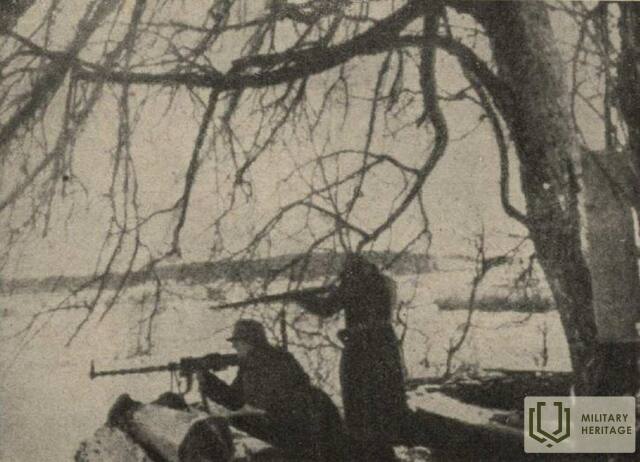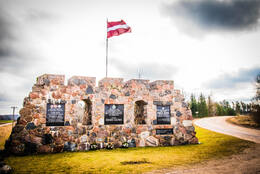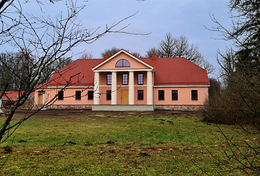Kapitono Aleksandro Levingo prisiminimai apie žvalgybinę ekspediciją virš Ventos netoli Leno
1919 m. vasarį abiejose Ventos upės pusėse vyko aktyvi žvalgyba. Vienas iš žvalgybinių reidų vadų buvo kavalerijos divizijos viršininkas kapitonas Aleksandras Loevingas.
Dar vienas nepamirštamas žvalgybinis žygis įvyko vasario 12 d. Ankstyvą rytą su 8 kavaleristais išjojome į Lėnus. Palikę arklius sargybos daliniui, pėsčiomis perėjome Ventos upę į kitą krantą, kur, prisidengę skardžiu, pradėjome judėti į šiaurę. Praėjome Pikulius, kur, kaip žinoma, buvo dislokuotas raudonasis būrys. Tada artėjome prie Birzniekų. Prie šių namų buvo pastebimas judėjimas, matėsi ir keli vežimai. Nurodžiau leitenantui (vėliau pulkininkui) Pukšiui nueiti ten su keliais kavaleriais. Aš pats ir kiti grįžome į savo Ventos upės krantą, užimdami pozicijas miško pakraštyje netoli Kurmių, kad galėtume paremti itn. Pukšio grupę ugnimi ir pridengti jos pasitraukimą. Bolševikai netrukus pastebėjo mūsų žvalgus ir norėjo juos pasukti atgal. Atidengėme ugnį, sukeldami didelę sumaištį priešo pusėje. Dabar mūsų grupei atėjo laikas pasitraukti. Bijojau, kad jei judėsime per greitai, įkrisime į upę, nes daugelyje vietų nebuvo ledo dangos. Kartu su leitenantu Zariniu perėjome upę atgal, pažymėdami perėjos vietą adatomis. Tada praslinkome pro pakrantės krūmynus, kad pamatytume, kur yra mūsų grupė. Nuo Kurmio miško pakraščio vis dar buvo šaudoma dengianti ugnis. Staiga, vos už maždaug 100 metrų, pamatėme iš netoliese esančio miško bėgančią raudonųjų grupę. Pradėjome šaudyti kiek įmanydami iš stovimos pozicijos, kad padarytume priešui moralinį įspūdį. Susidūrimas baigėsi tuo, kad bolševikai skubiai atsitraukė iš Birzniekų. Visi grįžome sveiki ir sveiki, nors ir suprakaitavę. Su dainomis išvykome į Lėną, kur jojome ant žirgų, kad nuvažiuotume į Rudbāržius su žinute pulkininkui.
Crippen A., Kalpako batalionas ir Balandžių brigada, Belimora, 1963 m.
Susijusi laiko juosta
Susijusios vietos
Švenčiausiosios Trejybės Romos katalikų bažnyčia Lėni mieste
Bažnyčia yra Lēnu kaime, Nīkrāce parapijoje, Skrundos savivaldybėje, prie kelio Skrunda – Embute.
Netoli bažnyčios teka Ventos upė, kurios krantus 1919 m. vasarį saugojo 1-ojo atskirojo Latvijos bataliono kariai. Kadangi bataliono karių skaičius neleido sukurti ištisinės fronto linijos, frontą saugojo sargybos postai. Vienas iš jų taip pat buvo įsikūręs upės krante netoli bažnyčios. Bažnyčios bokštai buvo naudingi stebint apylinkes ir kitą upės pusę.
1-ojo Latvijos atskirojo bataliono memorialas Lėnuose ir perkėlimo vieta prie Ventos upės
Paminklas yra Lėniuose, kelių sankryžoje netoli Lėnių dvaro.
Paminklas atidengtas 2007 m. lapkričio 8 d. Jį sukūrė skulptorė Maija Engele. Paminklo autorius ir finansuotojas yra Janis Blūms, kurio tėvas leitenantas Paulis Blūms, 1-ojo atskirojo Latvijos bataliono kavalerijos divizijos pirmasis leitenantas, 1919 m. kovo 3 d., padedamas 10 vyrų, organizavo ir vadovavo upės perėjimui.
Kasmet kovo 3 d. čia susirenka jaunieji sargybiniai, kariai ir kiti susidomėję asmenys, vykstantys 1-ojo Latvijos atskirojo bataliono pagerbimo renginyje.
Lėtas dvaras
Dvaro pilis yra Lėnų kaime, prie Ventos upės. Šiuo metu pilis yra privati nuosavybė, todėl ją galima pamatyti tik iš tolo.
Dvaro rūmai nuo 1919 m. sausio pabaigos iki kovo 3 d. buvo naudojami kaip 1-ojo Latvijos atskirojo bataliono atramos punktas. Latvijos atskirasis batalionas turėjo išlaisvinti Leni dvaro apylinkes, kad galėtų kirsti upę priešais Jaunmuižą.
Dvaras priklausė baronui Friedrichui von Firksui, kuriam taip pat priklausė Rudbāržzi ir Sieksate dvarai. Dvaro rūmai buvo pastatyti XIX a. Baronui Lēnu pilis daugiausia tarnavo kaip medžioklės ir savaitgalio poilsio vieta.
Nuo 1927 iki 1937 m. pilyje veikė mokykla, o sovietų okupacijos metu – kolūkio medienos dirbtuvės. 1965 m. atidarytas bendruomenės centras. Pastatų ansamblis buvo daug kartų pertvarkytas, o parkas neišsaugotas. Išliko keli ūkiniai pastatai.








